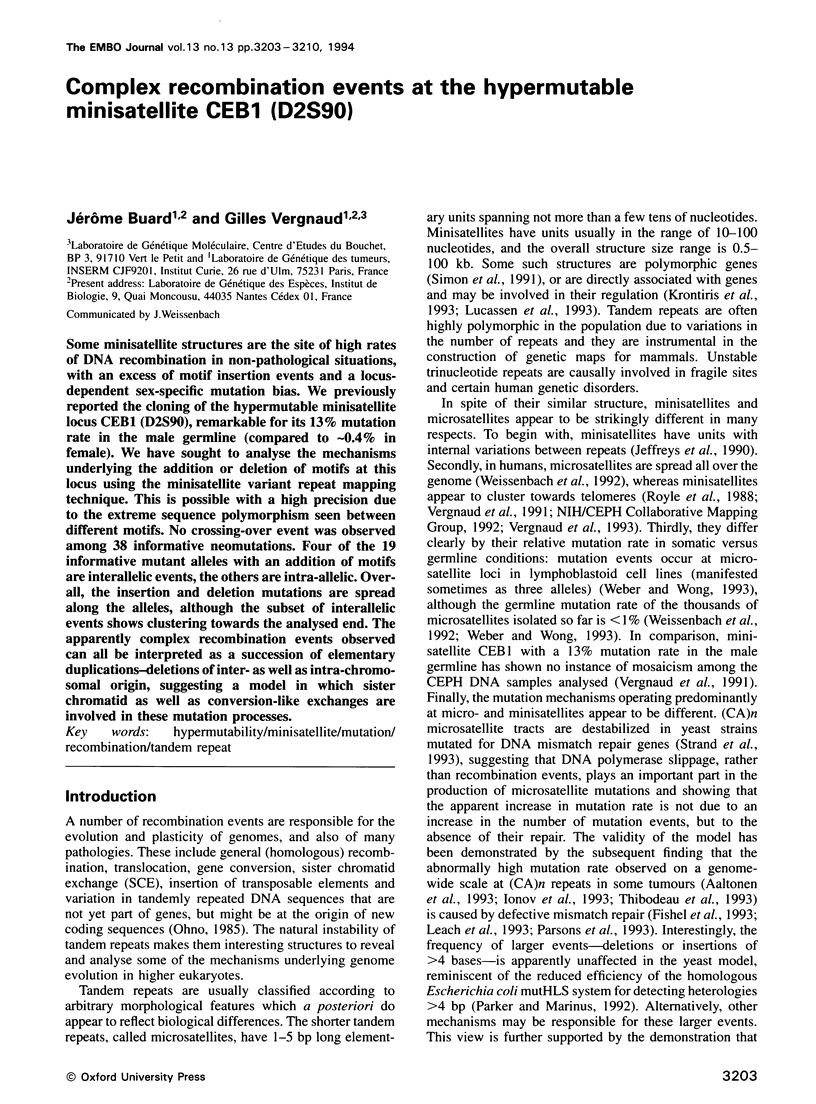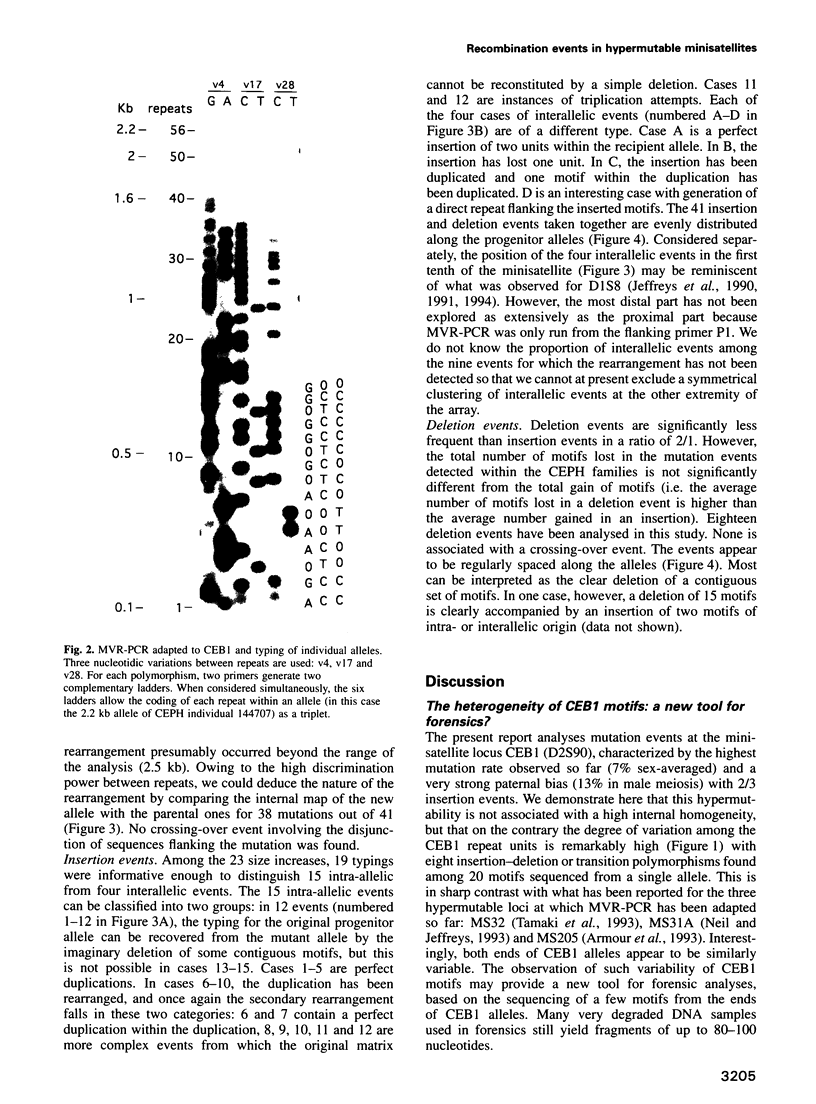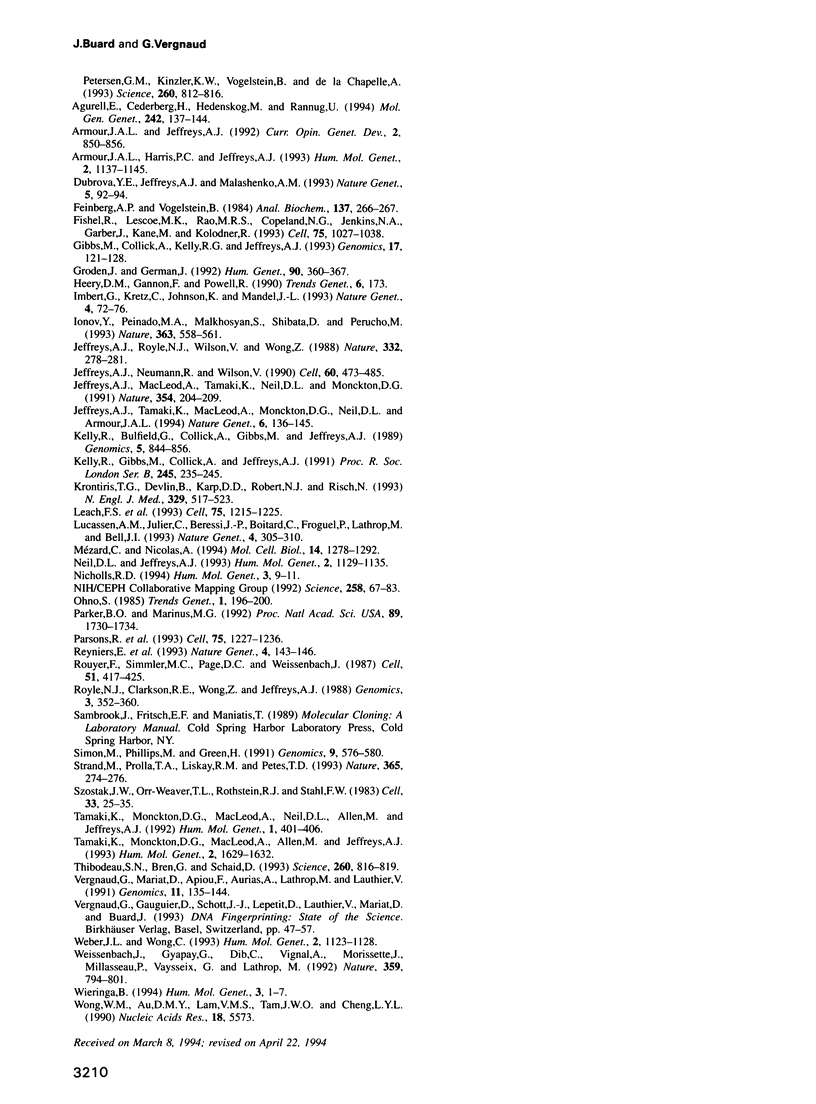Abstract
Some minisatellite structures are the site of high rates of DNA recombination in non-pathological situations, with an excess of motif insertion events and a locus-dependent sex-specific mutation bias. We previously reported the cloning of the hypermutable minisatellite locus CEB1 (D2S90), remarkable for its 13% mutation rate in the male germline (compared to approximately 0.4% in female). We have sought to analyse the mechanisms underlying the addition or deletion of motifs at this locus using the minisatellite variant repeat mapping technique. This is possible with a high precision due to the extreme sequence polymorphism seen between different motifs. No crossing-over event was observed among 38 informative neomutations. Four of the 19 informative mutant alleles with an addition of motifs are interallelic events, the others are intra-allelic. Overall, the insertion and deletion mutations are spread along the alleles, although the subset of interallelic events shows clustering towards the analysed end. The apparently complex recombination events observed can all be interpreted as a succession of elementary duplications-deletions of inter- as well as intra-chromosomal origin, suggesting a model in which sister chromatid as well as conversion-like exchanges are involved in these mutation processes.
Full text
PDF







Images in this article
Selected References
These references are in PubMed. This may not be the complete list of references from this article.
- Aaltonen L. A., Peltomäki P., Leach F. S., Sistonen P., Pylkkänen L., Mecklin J. P., Järvinen H., Powell S. M., Jen J., Hamilton S. R. Clues to the pathogenesis of familial colorectal cancer. Science. 1993 May 7;260(5109):812–816. doi: 10.1126/science.8484121. [DOI] [PubMed] [Google Scholar]
- Agurell E., Cederberg H., Hedenskog M., Rannug U. Chemically induced changes in the spectrum of amplifications of the human minisatellite MS1 integrated in chromosome III of a haploid yeast strain. Mol Gen Genet. 1994 Jan;242(2):137–144. doi: 10.1007/BF00391006. [DOI] [PubMed] [Google Scholar]
- Armour J. A., Harris P. C., Jeffreys A. J. Allelic diversity at minisatellite MS205 (D16S309): evidence for polarized variability. Hum Mol Genet. 1993 Aug;2(8):1137–1145. doi: 10.1093/hmg/2.8.1137. [DOI] [PubMed] [Google Scholar]
- Armour J. A., Jeffreys A. J. Biology and applications of human minisatellite loci. Curr Opin Genet Dev. 1992 Dec;2(6):850–856. doi: 10.1016/s0959-437x(05)80106-6. [DOI] [PubMed] [Google Scholar]
- Dubrova Y. E., Jeffreys A. J., Malashenko A. M. Mouse minisatellite mutations induced by ionizing radiation. Nat Genet. 1993 Sep;5(1):92–94. doi: 10.1038/ng0993-92. [DOI] [PubMed] [Google Scholar]
- Feinberg A. P., Vogelstein B. "A technique for radiolabeling DNA restriction endonuclease fragments to high specific activity". Addendum. Anal Biochem. 1984 Feb;137(1):266–267. doi: 10.1016/0003-2697(84)90381-6. [DOI] [PubMed] [Google Scholar]
- Fishel R., Lescoe M. K., Rao M. R., Copeland N. G., Jenkins N. A., Garber J., Kane M., Kolodner R. The human mutator gene homolog MSH2 and its association with hereditary nonpolyposis colon cancer. Cell. 1993 Dec 3;75(5):1027–1038. doi: 10.1016/0092-8674(93)90546-3. [DOI] [PubMed] [Google Scholar]
- Gibbs M., Collick A., Kelly R. G., Jeffreys A. J. A tetranucleotide repeat mouse minisatellite displaying substantial somatic instability during early preimplantation development. Genomics. 1993 Jul;17(1):121–128. doi: 10.1006/geno.1993.1292. [DOI] [PubMed] [Google Scholar]
- Groden J., German J. Bloom's syndrome. XVIII. Hypermutability at a tandem-repeat locus. Hum Genet. 1992 Dec;90(4):360–367. doi: 10.1007/BF00220459. [DOI] [PubMed] [Google Scholar]
- Heery D. M., Gannon F., Powell R. A simple method for subcloning DNA fragments from gel slices. Trends Genet. 1990 Jun;6(6):173–173. doi: 10.1016/0168-9525(90)90158-3. [DOI] [PubMed] [Google Scholar]
- Imbert G., Kretz C., Johnson K., Mandel J. L. Origin of the expansion mutation in myotonic dystrophy. Nat Genet. 1993 May;4(1):72–76. doi: 10.1038/ng0593-72. [DOI] [PubMed] [Google Scholar]
- Ionov Y., Peinado M. A., Malkhosyan S., Shibata D., Perucho M. Ubiquitous somatic mutations in simple repeated sequences reveal a new mechanism for colonic carcinogenesis. Nature. 1993 Jun 10;363(6429):558–561. doi: 10.1038/363558a0. [DOI] [PubMed] [Google Scholar]
- Jeffreys A. J., MacLeod A., Tamaki K., Neil D. L., Monckton D. G. Minisatellite repeat coding as a digital approach to DNA typing. Nature. 1991 Nov 21;354(6350):204–209. doi: 10.1038/354204a0. [DOI] [PubMed] [Google Scholar]
- Jeffreys A. J., Neumann R., Wilson V. Repeat unit sequence variation in minisatellites: a novel source of DNA polymorphism for studying variation and mutation by single molecule analysis. Cell. 1990 Feb 9;60(3):473–485. doi: 10.1016/0092-8674(90)90598-9. [DOI] [PubMed] [Google Scholar]
- Jeffreys A. J., Royle N. J., Wilson V., Wong Z. Spontaneous mutation rates to new length alleles at tandem-repetitive hypervariable loci in human DNA. Nature. 1988 Mar 17;332(6161):278–281. doi: 10.1038/332278a0. [DOI] [PubMed] [Google Scholar]
- Jeffreys A. J., Tamaki K., MacLeod A., Monckton D. G., Neil D. L., Armour J. A. Complex gene conversion events in germline mutation at human minisatellites. Nat Genet. 1994 Feb;6(2):136–145. doi: 10.1038/ng0294-136. [DOI] [PubMed] [Google Scholar]
- Kelly R., Bulfield G., Collick A., Gibbs M., Jeffreys A. J. Characterization of a highly unstable mouse minisatellite locus: evidence for somatic mutation during early development. Genomics. 1989 Nov;5(4):844–856. doi: 10.1016/0888-7543(89)90126-2. [DOI] [PubMed] [Google Scholar]
- Kelly R., Gibbs M., Collick A., Jeffreys A. J. Spontaneous mutation at the hypervariable mouse minisatellite locus Ms6-hm: flanking DNA sequence and analysis of germline and early somatic mutation events. Proc Biol Sci. 1991 Sep 23;245(1314):235–245. doi: 10.1098/rspb.1991.0115. [DOI] [PubMed] [Google Scholar]
- Krontiris T. G., Devlin B., Karp D. D., Robert N. J., Risch N. An association between the risk of cancer and mutations in the HRAS1 minisatellite locus. N Engl J Med. 1993 Aug 19;329(8):517–523. doi: 10.1056/NEJM199308193290801. [DOI] [PubMed] [Google Scholar]
- Leach F. S., Nicolaides N. C., Papadopoulos N., Liu B., Jen J., Parsons R., Peltomäki P., Sistonen P., Aaltonen L. A., Nyström-Lahti M. Mutations of a mutS homolog in hereditary nonpolyposis colorectal cancer. Cell. 1993 Dec 17;75(6):1215–1225. doi: 10.1016/0092-8674(93)90330-s. [DOI] [PubMed] [Google Scholar]
- Lucassen A. M., Julier C., Beressi J. P., Boitard C., Froguel P., Lathrop M., Bell J. I. Susceptibility to insulin dependent diabetes mellitus maps to a 4.1 kb segment of DNA spanning the insulin gene and associated VNTR. Nat Genet. 1993 Jul;4(3):305–310. doi: 10.1038/ng0793-305. [DOI] [PubMed] [Google Scholar]
- Mezard C., Nicolas A. Homologous, homeologous, and illegitimate repair of double-strand breaks during transformation of a wild-type strain and a rad52 mutant strain of Saccharomyces cerevisiae. Mol Cell Biol. 1994 Feb;14(2):1278–1292. doi: 10.1128/mcb.14.2.1278. [DOI] [PMC free article] [PubMed] [Google Scholar]
- Neil D. L., Jeffreys A. J. Digital DNA typing at a second hypervariable locus by minisatellite variant repeat mapping. Hum Mol Genet. 1993 Aug;2(8):1129–1135. doi: 10.1093/hmg/2.8.1129. [DOI] [PubMed] [Google Scholar]
- Nicholls R. D. Recombination model for generation of a submicroscopic deletion in familial Angelman syndrome. Hum Mol Genet. 1994 Jan;3(1):9–11. doi: 10.1093/hmg/3.1.9. [DOI] [PubMed] [Google Scholar]
- Parker B. O., Marinus M. G. Repair of DNA heteroduplexes containing small heterologous sequences in Escherichia coli. Proc Natl Acad Sci U S A. 1992 Mar 1;89(5):1730–1734. doi: 10.1073/pnas.89.5.1730. [DOI] [PMC free article] [PubMed] [Google Scholar]
- Parsons R., Li G. M., Longley M. J., Fang W. H., Papadopoulos N., Jen J., de la Chapelle A., Kinzler K. W., Vogelstein B., Modrich P. Hypermutability and mismatch repair deficiency in RER+ tumor cells. Cell. 1993 Dec 17;75(6):1227–1236. doi: 10.1016/0092-8674(93)90331-j. [DOI] [PubMed] [Google Scholar]
- Reyniers E., Vits L., De Boulle K., Van Roy B., Van Velzen D., de Graaff E., Verkerk A. J., Jorens H. Z., Darby J. K., Oostra B. The full mutation in the FMR-1 gene of male fragile X patients is absent in their sperm. Nat Genet. 1993 Jun;4(2):143–146. doi: 10.1038/ng0693-143. [DOI] [PubMed] [Google Scholar]
- Rouyer F., Simmler M. C., Page D. C., Weissenbach J. A sex chromosome rearrangement in a human XX male caused by Alu-Alu recombination. Cell. 1987 Nov 6;51(3):417–425. doi: 10.1016/0092-8674(87)90637-4. [DOI] [PubMed] [Google Scholar]
- Royle N. J., Clarkson R. E., Wong Z., Jeffreys A. J. Clustering of hypervariable minisatellites in the proterminal regions of human autosomes. Genomics. 1988 Nov;3(4):352–360. doi: 10.1016/0888-7543(88)90127-9. [DOI] [PubMed] [Google Scholar]
- Simon M., Phillips M., Green H. Polymorphism due to variable number of repeats in the human involucrin gene. Genomics. 1991 Apr;9(4):576–580. doi: 10.1016/0888-7543(91)90349-j. [DOI] [PubMed] [Google Scholar]
- Strand M., Prolla T. A., Liskay R. M., Petes T. D. Destabilization of tracts of simple repetitive DNA in yeast by mutations affecting DNA mismatch repair. Nature. 1993 Sep 16;365(6443):274–276. doi: 10.1038/365274a0. [DOI] [PubMed] [Google Scholar]
- Szostak J. W., Orr-Weaver T. L., Rothstein R. J., Stahl F. W. The double-strand-break repair model for recombination. Cell. 1983 May;33(1):25–35. doi: 10.1016/0092-8674(83)90331-8. [DOI] [PubMed] [Google Scholar]
- Tamaki K., Monckton D. G., MacLeod A., Allen M., Jeffreys A. J. Four-state MVR-PCR: increased discrimination of digital DNA typing by simultaneous analysis of two polymorphic sites within minisatellite variant repeats at D1S8. Hum Mol Genet. 1993 Oct;2(10):1629–1632. doi: 10.1093/hmg/2.10.1629. [DOI] [PubMed] [Google Scholar]
- Tamaki K., Monckton D. G., MacLeod A., Neil D. L., Allen M., Jeffreys A. J. Minisatellite variant repeat (MVR) mapping: analysis of 'null' repeat units at D1S8. Hum Mol Genet. 1992 Sep;1(6):401–406. doi: 10.1093/hmg/1.6.401. [DOI] [PubMed] [Google Scholar]
- Thibodeau S. N., Bren G., Schaid D. Microsatellite instability in cancer of the proximal colon. Science. 1993 May 7;260(5109):816–819. doi: 10.1126/science.8484122. [DOI] [PubMed] [Google Scholar]
- Vergnaud G., Gauguier D., Schott J. J., Lepetit D., Lauthier V., Mariat D., Buard J. Detection, cloning, and distribution of minisatellites in some mammalian genomes. EXS. 1993;67:47–57. doi: 10.1007/978-3-0348-8583-6_4. [DOI] [PubMed] [Google Scholar]
- Vergnaud G., Mariat D., Apiou F., Aurias A., Lathrop M., Lauthier V. The use of synthetic tandem repeats to isolate new VNTR loci: cloning of a human hypermutable sequence. Genomics. 1991 Sep;11(1):135–144. doi: 10.1016/0888-7543(91)90110-z. [DOI] [PubMed] [Google Scholar]
- Weber J. L., Wong C. Mutation of human short tandem repeats. Hum Mol Genet. 1993 Aug;2(8):1123–1128. doi: 10.1093/hmg/2.8.1123. [DOI] [PubMed] [Google Scholar]
- Weissenbach J., Gyapay G., Dib C., Vignal A., Morissette J., Millasseau P., Vaysseix G., Lathrop M. A second-generation linkage map of the human genome. Nature. 1992 Oct 29;359(6398):794–801. doi: 10.1038/359794a0. [DOI] [PubMed] [Google Scholar]
- Wieringa B. Myotonic dystrophy reviewed: back to the future? Hum Mol Genet. 1994 Jan;3(1):1–7. doi: 10.1093/hmg/3.1.1-a. [DOI] [PubMed] [Google Scholar]
- Wong W. M., Au D. M., Lam V. M., Tam J. W., Cheng L. Y. A simplified and improved method for the efficient double-stranded sequencing of mini-prep plasmid DNA. Nucleic Acids Res. 1990 Sep 25;18(18):5573–5573. doi: 10.1093/nar/18.18.5573. [DOI] [PMC free article] [PubMed] [Google Scholar]




